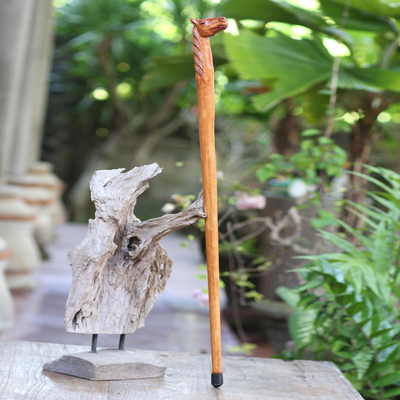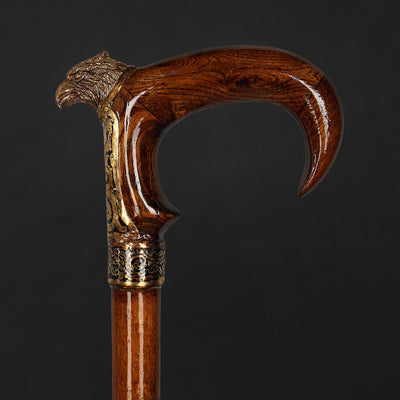You've seen people hiking with walking sticks.
Some are interesting, some plain. Some have been enhanced with a leather strap for ease of carrying or maybe even a bit of paint to personalize it.
But where do you get one, besides some store that wants to overcharge you for something you could probably make yourself?
Check your backyard. Or, when you're out for a hike yourself, look for fallen branches. Ones the length you need, or slightly longer, are good for a second look. So are ones with an exciting shape.
For a walking stick with an interesting texture, take a fallen branch off a cholla. When fresh, cholla limbs are thorny like a cactus. Once fallen, though, they lose their thorns and have a beautiful, almost woven pattern to them. For a smoother walking stick, try an old aspen branch. Find them in our tree nursery.

Source of Information on Finding your Walking Sticks
A Walking Stick Versus a Cane: A Comparative Exploration Walking sticks and canes are two commonly used mobility aids, each serving a distinct purpose and possessing unique characteristics. While they may appear similar at first glance, a deeper examination reveals significant design, functionality, and symbolism differences. This exploration will explore the nuances of walking sticks and canes, examining their historical context, practical applications, cultural significance, and psychological impact on users.
Historical Evolution
The history of walking sticks and canes dates back thousands of years, with evidence of their use found in ancient civilizations across the globe. Initially employed primarily for support during walking, these devices evolved to serve various purposes, including status symbols, fashion accessories, and weapons.
Walking Sticks
Walking sticks, also known as hiking sticks or trekking poles, have a long history rooted in practicality. Early humans likely used sticks found in nature to aid in balance and stability while traversing uneven terrain. Over time, these rudimentary tools were refined and adapted for specific purposes, such as hunting, hiking, and exploration.
Walking sticks are associated with authority, leadership, and wisdom in many cultures. Tribal chiefs, elders, and religious figures often carried ornately decorated staffs to symbolize their status and authority. For example, the biblical staff of Moses and the scepters of kings and queens are iconic examples of this symbolism.
Canes
On the other hand, canes have a more formal and refined history, often associated with urban environments and aristocratic society. Canes as fashionable accessories gained prominence during the Renaissance period in Europe. Nobility and wealthy individuals began using elaborately designed canes from luxurious materials such as ivory, gold, and precious gems.
During the 17th and 18th centuries, canes became fashionable among gentlemen as symbols of elegance, refinement, and social status. They were not only functional aids for walking but also served as fashion statements and status symbols. Canes were often intricately carved and adorned with decorative handles representing various motifs, including animals, mythological figures, and historical events.
Design and Functionality
Despite their shared purpose of aiding mobility, walking sticks and canes differ significantly in design and functionality.
Walking Stick Versus a Cane
Walking sticks are typically longer and feature a simple, straight design. They are often made from lightweight materials such as wood, aluminum, or carbon fiber to enhance durability without adding unnecessary weight. Walking sticks commonly feature ergonomic handles, wrist straps, and adjustable height settings to provide users with optimal comfort and support during outdoor activities such as hiking, trekking, and walking.
One distinguishing feature of walking sticks is their versatility. They are designed to provide stability and balance on various types of terrain, including trails, uneven ground, and steep slopes. Some walking sticks also come equipped with shock-absorbing mechanisms and interchangeable tips to adapt to different environments and weather conditions.
Canes
On the other hand, canes are more diverse in design and cater to a broader range of preferences and needs. They come in various styles, lengths, and handle shapes, allowing users to choose the option that best suits their requirements and aesthetic preferences.
Traditional canes typically feature a curved or crook handle, providing users a secure grip and additional support while walking. However, modern canes may incorporate ergonomic handles, offset handles, or T-shaped handles to accommodate different hand sizes and reduce strain on the wrists and palms.
In addition to their functional benefits, canes often serve as fashion accessories and personal statements. They are available in many designs, colors, and materials, from classic wooden canes to contemporary metal or acrylic canes adorned with intricate patterns or motifs.
Cultural and Symbolic Significance Of Walking Stick Versus a Cane
Walking sticks and canes carry significant cultural and symbolic meanings, reflecting different societies' values, traditions, and social norms.
Walking Sticks
In many indigenous cultures, walking sticks hold spiritual significance and are imbued with symbolic meanings associated with nature, spirituality, and ancestral wisdom. They are often crafted from natural materials in the surrounding environment, such as wood, bone, or antler. They may feature carvings or decorations representing tribal motifs, animal totems, or sacred symbols.
Walking sticks are also deeply ingrained in outdoor pursuits such as hiking, trekking, and mountaineering, symbolizing adventure, exploration, and self-reliance. For many outdoor enthusiasts, a trusty walking stick is essential, providing support, stability, and a sense of connection to the natural world.
Canes
Canes have historically been associated with power, authority, and social status, particularly among the aristocracy and upper classes. In Western societies, using a cane was often regarded as a sign of refinement, sophistication, and cultural sophistication.

During the Victorian era, elaborate Walking Stick Versus a Cane
adorned with intricate carvings, precious metals, and gemstones became fashionable accessories among the upper echelons of society. Canes were not only practical aids for walking but also served as status symbols and conversation pieces, reflecting their owners' wealth, taste, and social standing.
Psychological Impact
The psychological impact of walking sticks and canes extends beyond their physical utility, influencing users' perceptions of themselves and their interactions with the world around them.
Walking Sticks
For many individuals, particularly those with mobility limitations or disabilities, walking sticks can empower them to engage in outdoor activities and pursue adventures that might otherwise be inaccessible. A well-crafted walking stick can instill confidence, independence, and self-reliance, enabling users to overcome obstacles and explore the great outdoors with greater freedom and autonomy.
Canes
Canes can profoundly impact users' self-image and identity, mainly when used as fashion accessories or style statements. A carefully chosen cane can enhance one's sense of personal style, individuality, and self-expression, reflecting their personality, taste, and cultural identity.
However, canes may also carry negative connotations for some individuals, particularly those who associate them with aging, disability, or dependence. The decision to use a cane can be fraught with complex emotions, including pride, reluctance, and acceptance, as users navigate societal perceptions and stereotypes associated with mobility aids.

Walking Stick Versus a Cane
They are more than just tools for mobility; they are artifacts of human history, cultural symbols, and personal statements. While walking sticks are rooted in practicality and outdoor adventure, canes are imbued with elegance, refinement, and social status. Each device carries its unique history, design, and symbolism, shaping how users perceive themselves and interact with the world around them.
Choosing a walking stick or a cane relies on different factors, like personal choices, lifestyle, and mobility needs. Both devices serve essential functions in facilitating movement and enhancing independence, allowing users to navigate the world with greater confidence, comfort, and style.


















































